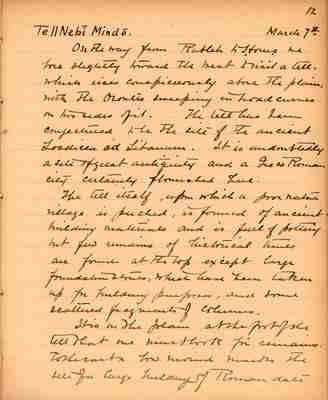Pages That Mention Homs
Butler Diary: Northern and Central Syria V, 1900
BSY_FB_17-12
12
On the way from Rableh to Ḥomṣ we bore slightly toward the west to visit a tell which arises conspicuously above the plain, with the Orontes sweeping in broad curves on two sides of it. The tell has been conjectured to be the site of the ancient Laodicea ad Libanum. It is undoubtedly a site of great antiquity and a Greco Roman city certainly flourished here.
The tell itself, upon which a poor native village is perched, is formed of ancient building materials and is full of pottery but few remains of historical times are found at the top except large foundation stones, which have been taken up for building purposes, and some scattered fragments of columns.
It is in the plain at the foot of the tell that one must look for remains. To the east a low mound marks the site of a large building of Roman date
BSY_FB_17-14
14
The site of ancient Emessa preserves but one architectural fragment of antiquity, this is a ruined tomb structure just outside the limits of the modern town on the high road to Tripoli.
The monument besides being the only remnant of the ancient city is of great interest in itself as one of the few Roman structures preserved to us in which the masonry was designed to give a polychromatic effect.
The tomb was a square tower like structure ^38 feet sq^ of two stories and an attic with vaulted chambers, built all of concrete faced with opus reticulatum and adorned with pilasters and mouldings.
The reticulated work was executed in a white limestone in which a simple pattern is wrought in black basalt. The pilasters are built up of brick shaped blocks of the
BSY_FB_17-17
17
From Ḥomṣ we travelled about six hours to the northeast to a modern village, of the above name, situated within a mound formed of the decayed walls of an ancient city,
It is evident that these walls were of sundried brick which has disintegrated into shapeless clay - several niches in the four-square wall seem to mark the position of gates, and on either side can still be seen large blocks of stone half buried in the mound. Within the wall a huge mound is still visible but nothing short of excavations could reveal anything of importance.
In the courtyard of the house where we spent the night is a colossal head of stone The head is high, the face long and the crown of the head is covered with a close fitting cap adorned with an incised pattern of spirals. The face is broad across the eyes which are represented by deep hollows



